Are you ready to pursue the road trip of a lifetime? Solo female van life gives you the chance to explore the forests, beaches and mountains 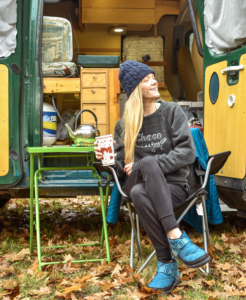
Your “normal” everyday routine will be replaced with intentional, minimalist living routines. You’ll meet people with similar mindsets, adventure to new places, and maybe most importantly, learn more about yourself.
I wanted to try life on the road in order to understand what a happy life meant to me. I wanted lots of uninterrupted solo time to reflect on things before figuring out what my next “big move” in life was.
So, I built out a simple DIY van conversion, transitioned my full-time digital marketing job to freelancer work, and set out on the open road.
It’s been three years since starting solo van life. I now rent out my van and am back living in a house. But I’m sharing my ultimate guide on how to make the transition to solo female van life as smooth as possible. From my own experiences to my nomad friends’ stories, all of my best hacks and van life essentials are packed into this guide.
Phase 1: Plan Your Van Life
I call this “Phase 1” of your van life journey, where you aren’t on the road yet but in the very beginning stages of your van life and van build research.
Get a Taste of the Lifestyle Through Vlogs
There are so, so many vanlifers that share their experiences through vlogs, social media or regular blogs (like this one!). Checking out multiple accounts is a great way to get an idea of what daily solo female van life looks like.
Some of my solo female van life friends that vlog on YouTube include:
- Brenda of TheRoadThroughMyEyes
- Alyssa of Regretlyss (she lives in a skoolie, but still solo female!)
- Bronte of the Box Car Chronicles
- Traveling Solo Series (a full video series presented by Tiny Home Tours)
- My own van tour video with Tiny Home Tours
Decide If You’ll Document the Process
Whether you’re interested in documenting your own van life adventures for personal reasons or to share with friends, family, and on social media, I recommend deciding now. The sooner you hit that record button, the fuller-picture you will have in the long-run of all your ups and downs!
Many vanlifers only start sharing their experiences once they’re actually on the road, or they get hung up on production quality. My advice: don’t overthink it and treat it like a documentary, not a feature film! You’ll thank yourself later as you say, “I totally forgot when [X] happened!”
On the flip side, do NOT feel pressure to share your journey with ANYONE. Whether you document it or not, at the end of the day, this experience is for YOU and YOU ONLY. It’s just up to you to decide what you’re hoping to glean from it.
A Luxury or Budget Van Conversion
Typically, your most luxury van builds will be found in Sprinter vans, Ford Transits or RAM Promasters. You’ll have the most comfortable setup in one of these thanks to their high roofs and spacious interiors. You’ll be looking at a price tag of roughly $34,000 – $55,000 to buy one of these brand new and not built-out.
On the opposite end of the spectrum are the older, budget-friendly vans. If you don’t mind an extra tiny home on wheels, you can save thousands of dollars opting for a used Ford Econoline, Chevy Express, Astro van or GMC Savana (or even a minivan such as the Toyota Sienna). While the base model of these vans doesn’t have a raised roof, you can definitely find these on the market with custom extended raised roofs.
Check out my post that covers why campervans are expensive and how to choose between a luxury or budget build. You can find used and new vans for sale on Facebook Marketplace, Van Life Trader, RVT.com, Conversion Trader, or RV Trader–just to name a few.
A Pre-Built or DIY Van Build
Figuring out if you want to buy an already-built out van, versus doing the van build yourself, will really affect your budget and timeline. According to my friends Two Roaming Souls, an average professional van build will run around $30K – $80K (not including the van). But you can also opt for modular van builds that run closer to $10K (check out Oasis Campervans, Wayfarer Vans, Contravans or Cascade Campers).
Going the DIY route will be a wild ride–trust me! Expect the unexpected. Don’t be surprised when you change your mind and completely pivot van plans halfway through the build. These things just happen, but I see THIS as the beginning of your van life journey; not when you hit the road. Check out my own DIY van conversion costs to get an idea. You can usually expect DIY van build costs around $1K – $10K.
*BONUS*: Get access to Project Van Life’s online courses, Van Life Academy, that walk you through every part of the DIY van build. Taught by van build experts on over 6 different makes and models of vans.
Part-time or Full-time Vanlifer
Do you want to sell all of your possessions and hit the road full-time, or do you want to be a weekend warrior, or just travel when you can?
There’s a lot less overhead if you aren’t going full-time. You can keep your current residence (and not have to sell everything or put it in storage) and you can be a little more lax with the amenities and build design of your van, since you’ll only be in it for stints at a time.
But on the plus-side of going full-time, you immerse yourself in the lifestyle and challenge yourself to a new way of living (and thinking). To me, that’s an invaluable lesson that you will carry for life.
I recommend going on short trips in the van so you can test out the lifestyle before deciding if you want go to full-time or part-time. If you haven’t bought a van yet, I highly recommend renting out different types of campervans to test out the lifestyle and the type of build you want! Check out Outdoorsy–it’s my favorite place to find any type of campervan rental.
Set Your Monthly Budget
A vanlifer’s budget typically ranges from $800-$2K per month. Of course, this is totally up to you and what you feel comfortable spending each month. Read my full breakdown of common monthly van life costs (which usually include gas, food, gym memberships, subscriptions, campervan insurance, health insurance and emergency funds).
Use my Monthly Gas Costs Calculation Guide to estimate your own monthly gas costs.
A good place to start is figuring out what you currently spend per month, then factoring in things such as your gas costs replacing rent. Regardless of what your monthly budget is, it’s a good idea to set aside emergency funds in case you had an auto or health emergency. Better to be safe than sorry!
Practice Going on Solo Adventures
You’re probably used to doing some things solo already, such as running errands or maybe even going to the movies. But in solo female van life, everything is a solo trip…and you aren’t coming home to the company of roommates!
On a Friday night you may ask, “what should we do tonight?” only to realize you’re talking to yourself…which is (IMO) one of the toughest but best self-reflective learning experiences from the road.
That’s why I suggest trying more solo activities before you make the leap to solo van life. Walk around a park, go on a small hike, go out to eat, grab a coffee, get comfortable with your own company!
Consider a Self-Defense Class
There is only so much a weapon can do if a predator catches you off-guard and you don’t have it on you. Not only will basic self-defense techniques potentially get you out of a dangerous situation, but they can give you incredible peace of mind as you launch into this “longterm” road trip.
I think it’s especially important to have some of these skill when you are off-grid for days at a time. Because after a couple of days posted up at the same camp spot, you tend to let your guard down and casually explore the surrounding area. But that’s when it’s really easy to forget your basic safety measures (like keeping a taser, gun or knife on you).
Will You Bring a Pet?
I think most of us with pets aren’t afraid to admit our furry pals are our go-to best friends. So what would be better than having your best friend on a never-ending roadtrip?
Bringing a pet will change a lot about your van life setup and experience! I brought my cat for a portion of my van life journey and it was amazing to watch him blossom from a house-bound cat to a tree-climbing, dog-befriending, rambunctious little rascal.
But like with any living being, you need to factor in their needs just as much as your own. Do you think they will adjust well? Is your pet more adventurous or prone to anxiety? Can you handle loads of fur all over your tiny house? What if you want to leave your van for hours at a time? Will they have a designated space in your van? The list goes on…
Check out my van friends’ Q&A on van life with a dog to help you make the RUFF call.
Set a Timeline
It’s too easy to lose days or weeks of time because you randomly went down some rabbit hole about your van build, or van planning, or got stuck in analysis paralysis. A great way to keep yourself on track is to set a loose timeline and hold yourself accountable to it.
It helps to do one productive thing a day towards getting on the road, even if it’s a tiny task. It’s the little things that build into big things, and it will help keep you in a productive and motivated mindset.
Phase 2: Prep Your Van (& Yourself)
This is the phase where you’re gearing up to hit the road. It’s the critical phase of thinking through every aspect of your van build and every essential you may need on the road.
Join Solo Female Van Life Facebook Groups
During my van build process, I was constantly visiting the Women’s Vanlife Collective Facebook group. These ladies keep it REAL, and even though I enjoyed watching influencers’ experiences, I wanted the people who weren’t afraid to talk about the ugly, dirty and overwhelming sides of being a solo female traveler.
I found it to be a very welcoming group that would give you supportive answers even if you thought you were asking a “dumb” question. I also enjoyed just reading women’s posts to get a feel for what everyday obstacles were like on the road. Women from all walks of life are in this group so it’s a great, holistic picture of van living as a woman.
Checkout my roundup of 41 Lessons Learned from Women Living in Vans (these responses came from the Women’s Vanlife Collective FB group!).
Consider Your Current Everyday Needs
We all have our little daily habits that make up the comforts of the day. Maybe it’s that morning cup of coffee, that post-work shower, the midday workout, cooking a meal or watching your favorite show. Whatever it is, consider how you’ll incorporate that into your daily life on the road.
Don’t make the mistake of thinking that just because you change your surroundings, your “typical” needs or problems will go away. If anything, living in a tiny space usually makes them worse! Make sure you have a way to REALLY feel comfortable in your campervan.
Practice Sleeping in the Van
Curious about how well you’ll sleep on the road every night? Maybe your memory foam mattress is going to turn into rock-hard block in chilly temps, or your van’s insulation isn’t good at keeping out noise. Or maybe your blackout curtains aren’t covering every inch of light seeping in through the windows?!
Doing some trial runs in your van (from your driveway!) is a great way to work out all the little kinks so there are no surprises on the road. I also recommend running through other morning tasks–for example I made coffee in the van from my driveway and it helped me realize I had to adjust the placement of my stove so I could use it properly!
Pack Light & Smart
I recommend investing in some clothing items that are high-quality, multifunctional, durable, breathable, super comfortable and you still feel cute in. Brands such as REI, Backcountry and KUHL specialize in stylish and comfortable outdoor clothing for women. The reason I recommend this is because you can minimize the amount of space used by clothing, and cut down on van life laundry! Check out my van life laundry pro tips here.
Have a Bathroom Setup in Your Van
There are all sorts of portable toilet options–some fancier than others. You may be planning on just using the great outdoors or public bathrooms as your main way to take care of business, but it’s important to have an emergency bathroom setup!
There will be nights where you may be in a parking lot or public area, or don’t feel particularly safe exiting your van to use the restroom. Or–heaven forbid you have an upset stomach–whatever the case, you need a quick and clean way to go to the bathroom from inside your van.
I recommend a widemouth, tight-seal Nalgene bottle for those late night pees and a simple collapsible toilet (use compostable waste bags and zip ties!). Here’s my own vanlife toilet setup!
PRO TIP: Avoid the SheWee or female funnel pee devices. They are good in theory, but I know many female vanlifers who don’t like them because they don’t work properly (and you get pee on yourself) and once you use it, you now have to clean it, making it difficult to carry around.
Start Planning Your Route
One of the most beautiful things about van life is being able to go wherever the wind blows you. But it can be hard to break the “roadtrip” mindset of feeling like you constantly have to be somewhere at a certain time.
I think a good way to strike a balance is setting a loose route for yourself, but going with the flow if new opportunities pop up. Many vanlifers head to the southwestern deserts of Arizona, New Mexico and California in the winter months (or Baja, Mexico if they’re feeling bold!). They work their way up to the Pacific Northwest as the temperatures start to warm up.
Figure Out a Safety Routine
The best way to stay safe on the road is by avoiding danger in the first place. Yes you can opt to carry weapons (I recommend this stun baton gun and handheld tase gun) but by developing a safety routine you can reduce the chances of having to use your weapons.
Solo Female Van Life Safety Tips
- Leave a pair of big men’s boots outside your van at night, to give the impression of a couple people in the van–and at least one big burly dude.
- Get to your camp spot before dark so you can properly evaluate the area, know your surroundings, and plan a quick exit route if needed.
- When parking for the night, face your van towards the exit so you don’t have to first reverse and turn-around.
- Keep your keys right by your bed, as well as a flashlight (and, if you choose to have a weapon, that as well!)
- Remember to LOCK ALL DOORS AT NIGHT! I’m sure this is a given, but it’s easy to park your van, get out for a quick second, then get back in and forget to hit the lock button again.
- Minimize trips between your van and the restrooms / wherever you need to get out. The more times you leave your van, the more opportunity for people to see that you’re in there alone.
- Minimize using your interior lights and/or put shades over your windows as soon as possible, so you aren’t giving any passersby a free to show to inside your living space.
- Trust your gut! If an area feels too remote, or the crowd feels unnerving, move on.
Phase 3: Launch into Solo Van Life
Welcome to the open road! Where are you most excited to visit first? I imagine you’re feeling all sorts of things!
Use Boondocking Apps to Find Camp Spots
Not sure where you can find safe (and free) camp spots every night? Have no fear–there are lots of boondocking apps that will show you free campspots on public lands, gas and food resources, cellphone signal coverage, and even if other vandwellers are in the area.
My Favorite Boondocking Apps:
Stay with Friends or Family
When I first hit the road, I spent a few nights at my childhood friend’s house and then my cousin’s house. It helped me ease into solo female van life so I could fly solo all day, but have a safe and homey environment to spend the night at.
This is also especially helpful if you are traveling through a city or urban area where it’s hard to find parking. And bonus, you’ll probably get a free shower and bathroom!
Consider Paid Overnight Parking
The biggest perks of paid overnight camp spots is that they are guaranteed and safe. While most vanlifers don’t rely on paid campspots as their main form of boondocking, it occasionally makes sense, say, if you are visiting a national park or are in an area with limited camp spots.
My Favorite Apps for Finding Paid Camp Spots:
Snag the camp spot of your dreams
Download Offline Google Maps
If you’re headed to an off-grid area and aren’t sure you will have cell signal, I recommend downloading a map of the area through Google Maps Offline Download feature. This is an easy safety tip that can save you a lot of trouble if things go south.
Get a Nationwide Gym Membership
Nationwide gym memberships are hands-down the cheapest and most convenient way to get access to shower and bathroom facilities across the country! Monthly fees typically run around $20-$40 with one-time startup fees around $50. Read my full guide on the best gym memberships for van life.
Download Your Favorite Movies & Shows
Just because you’re living in a van, doesn’t mean you can’t binge-watch your favorite shows! Streaming service apps such as Hulu and Netflix let you download shows so you can watch them later, without using cell phone data. This is great if you are camping somewhere without cell service or you have a limited data phone plan and need to save data as much as possible.
Pick Binge-Worthy Podcast or Audio Books
Podcasts and audio books have become my best friend on the road. You might love jamming out to music, but after so many hours of driving, it’s nice to get lost in a good story. I recommend downloading a bunch of podcast episodes or an audio book while you are on wifi–this way they won’t suddenly stop on you during a drive with patches of no cell signal.
Start Chatting with Other Road Travelers
The most popular ways that vanlifers meet and start chatting with other vanlifers is through Instagram and Facebook groups. You can get a feel for who these people are before you meet them in person, which is nice!
Typically, the snowball effect happens where you meet one solo female traveler, who has another traveling friend, so you then meet them through your friend, but then you bring a new friend into the mix…before you know it, you have a group of like-minded ladies having a blast out in the boonies!
Phase 4: Thrive on the Road
Spread those wings, let that freak flag fly, get ready for embracing all of life’s wild adventures!
Hit Up Your Favorite National Parks
There’s something really rewarding about going to a national park midweek and getting the place (hopefully) to yourself. Better yet, visit during the offseason to double your chances of total solitude with some of the most beautiful places in our country.
If you plan on touring around lots of national parks, I highly recommend buying the “America the Beautiful” national parks pass for $80/year. Given that the entrance fee to the Grand Canyon is $30 alone, you’ll be saving money after 3-4 national park visits.
Head to Van Life Gatherings
If you are feeling a bit isolated or lonely on the road, a van life gathering is a great way to make new connections and lift your spirits. Even introverted vandwellers (there are many!) can feel refreshed after a van life gathering because it simply mixes things up and distracts from getting lost in your own thoughts. Check out my list of all the van gatherings I know of!
Aim to Stay Tidy & Organized
One of the best ways I’ve found to keep a clear head is to keep a clean van–I know, cheesy but true! Sure we all have our lazy days, but if you can clean up messes soon after making them, you don’t wind up feeling overwhelmed by a big mess later.
If you can return items to their designated storage spaces, it’ll make a for a quicker cleaning time since you won’t have to think about where to put away everything. Check out my top tips for keeping your van clean and organized.
Meet Up with Other Vandwellers
So maybe you REALLY don’t like large gatherings, but you’d still like to make new connections. This is where using apps such as Instagram or Facebook groups can help you plan a one-on-one meetup with a new friend or two. If you hit it off, it’s so so nice to have a fellow nomad on the road that you can meet up with occasionally when you’ve been traveling solo for a little too long.
Pick Up Part-Time Work
A really productive way to spend some extra time on the road is picking up part-time work. Earn money, learn new stuff, and make new connections! There are all sorts of job types available to road travelers–use one of these 18 gig apps for finding local, short-term work or (if you prefer remote work) you can opt for one of these 15 remote van life jobs.
Pursue Hobbies or Interests
Is there a sport you’ve always loved playing? Are you really into DIY arts and crafts? Do you love cooking or going on sunset hikes? Whatever floats your boat, I encourage you to keep doing it from the road!
The benefits of pursuing your hobbies on the road are that 1) it grounds you and can help you think clearly if you’re feeling overwhelmed by van life and 2) if you try it in a new location, you’ll make new connections and keep getting better!
Keep Communication Lines Open
You’ll inevitably hit ups and downs on the road, and it can be really beneficial to keep regular contact with your support crew (whether that’s family or friends). Share your location with them and let them come along on your journey (even if it’s just by text message or Snapchat!).
Give Yourself Some R&R
Van life is a once in a lifetime experience–it’s also exhausting at times. There is nothing better than booking a hotel or AirBnB for a few nights to take a break from the van. Or better yet, crashing at a friend’s place for a bit.
Let van life help you find your own boundaries, and when you find them, accept them–don’t force yourself into uncomfortable or tiring situations simply because you want to prove yourself to yourself.
Summing It Up
So, are you ready to make the leap to solo female van life? Just remember that with any big decision in life, you may never feel 100% ready to make it, but sometimes–jumping in is the best way to move forward. Because adventure awaits!
Save this on Pinterest!
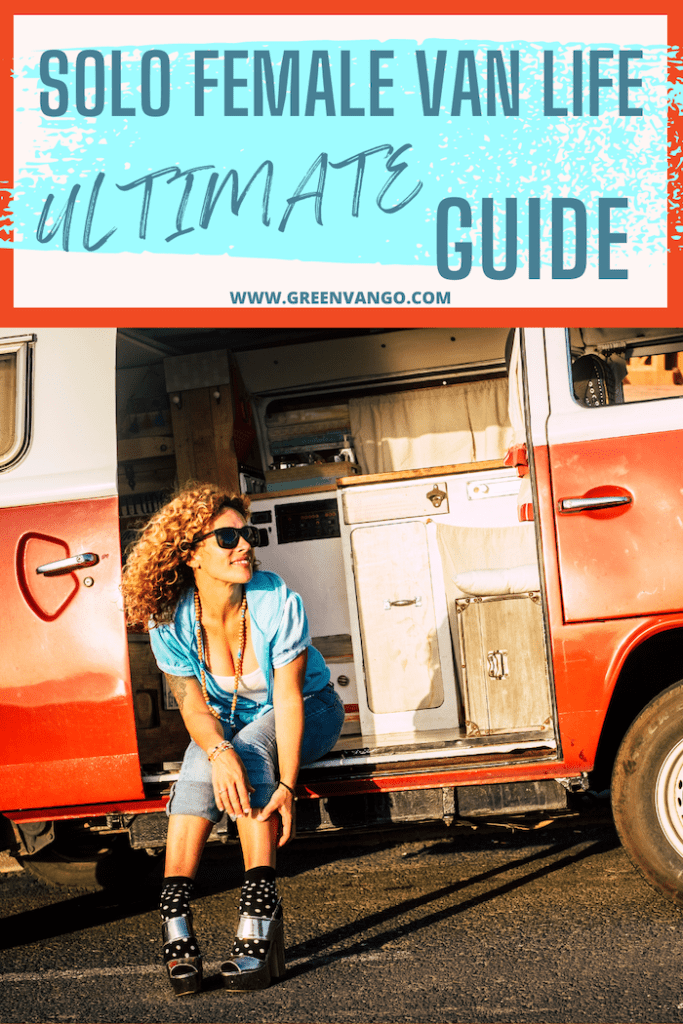
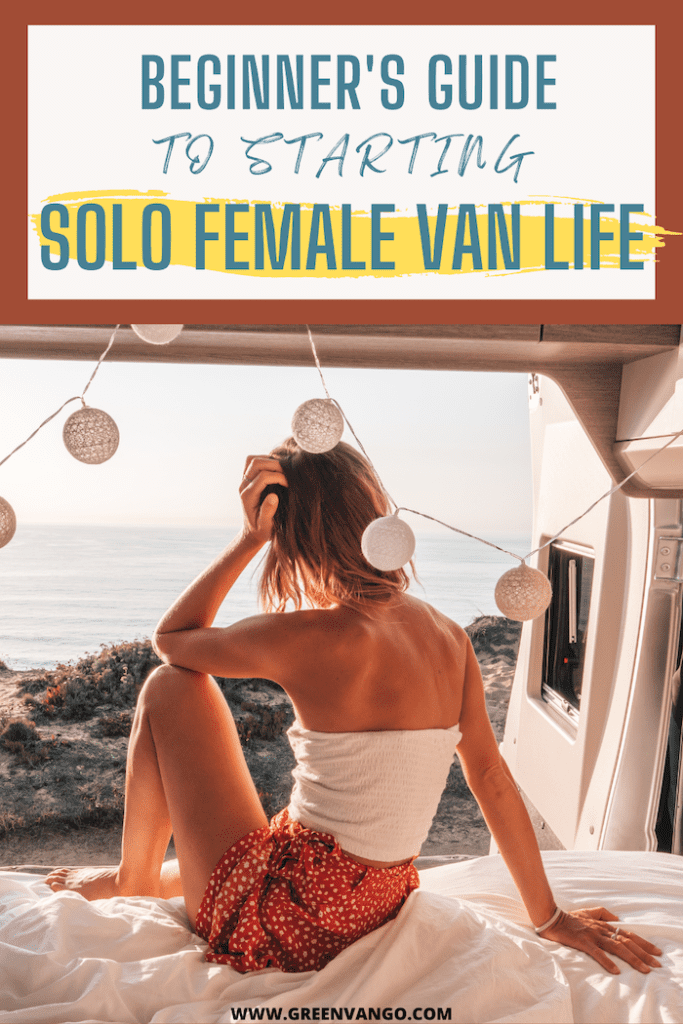

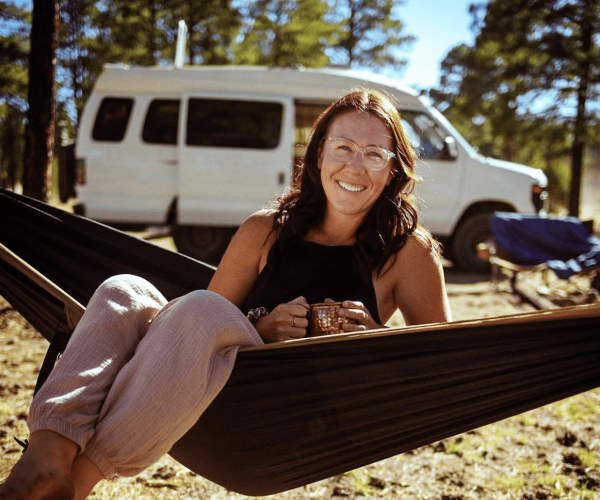
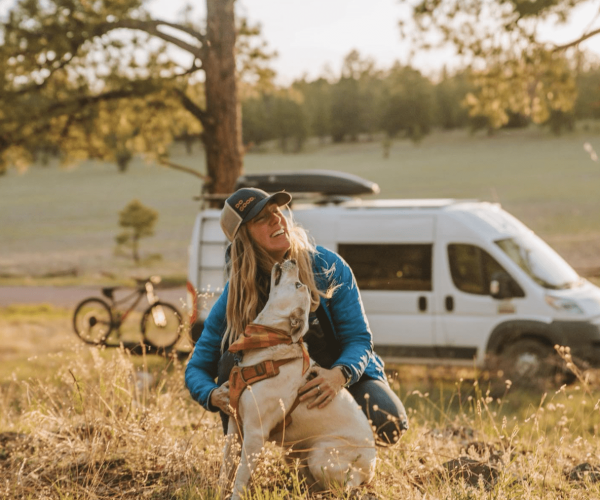

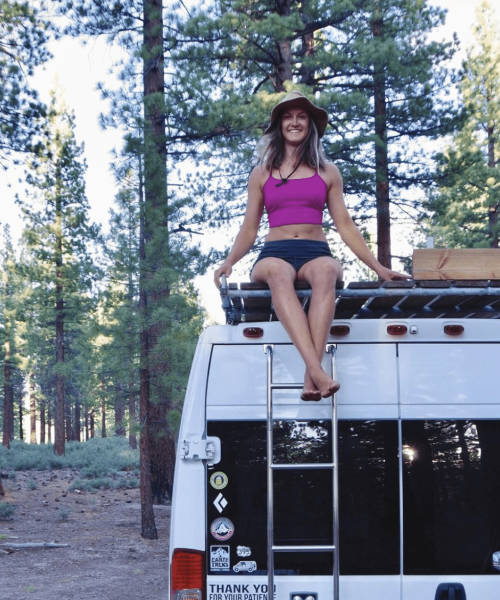
2 Comments
Lenie T.
I’m homeless and have to travel in my 2018 Ford focus SE for now. Am still making payments on it. Have 50,000 miles on it. Om interested in vanlife but are cars exceptable in meantime? And how to find out more info.
Hilary
Hi Lenie, absolutely – your travel vehicle is totally up to you and it’s about whatever YOU decide is acceptable for you 🙂 50,000 miles is pretty low mileage, which is great. You will definitely save money on fuel efficiency as well. Here’s a high-level overview of my tips on how to start van life, if that’s what you’re aiming for! https://www.outdoorsynomad.com/how-to-start-van-life/